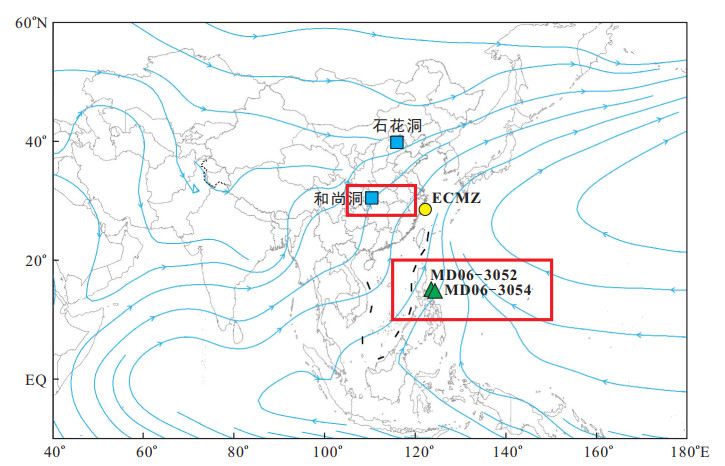Interpretation of stalagmite δ18O in East Asian summer monsoon region: Based on the relationship between summer monsoon and summer monsoon rainfall
-
摘要:
近些年,对于东亚季风区石笋
δ 18O的气候环境指示意义的争论较多,主要在东亚季风区石笋δ 18O代表夏季和风强度、夏季风降水还是水汽源变化。基于中国东部华北地区降水与长江中下游地区降水反相变化和长江中下游地区降水与菲律宾海降水反相变化(遥相关),从年际-年代际到千年-轨道尺度对石笋δ 18O与夏季风降水、厄尔尼诺-南方涛动(ENSO)的相互关系进行了探讨分析。通过对比石笋δ 18O记录与华北和梅雨区降水,发现石笋δ 18O偏负对应华北降水增加,梅雨区降水减少;石笋δ 18O偏正对应华北降水减少,梅雨区降水增加。这种对应关系不仅存在年际-年代际尺度,而且在千年-轨道尺度同样存在,石笋δ 18O不仅反映夏季风强弱变化,同时与中国东部区域降水关系是明确对应的。通过降水的空间相互关系,发现ENSO活动主要通过影响中国东部降水的空间分布格局而作用于石笋δ 18O。La Niña态导致南海及菲律宾海对流加强,西太副高位置偏北,长江中下游地区梅雨期缩短,华北夏季降水增加,东亚季风区石笋δ 18O偏负。El Niño态,南海和菲律宾海对流受到抑制,西太副高位置南移,长江中下游地区梅雨期延长,华北夏季降水减少,东亚季风区石笋δ 18O偏正。另外,水汽源分析发现,菲律宾海水汽输送对东亚季风区降水及降水δ 18O贡献相对较小。因此,综合分析认为,东亚季风区石笋δ 18O主要反映了亚洲夏季风的强弱变化。Abstract:The climate significance of stalagmite
δ 18O values from the East Asian monsoon region are still under much debated during the past years. The bone of contention focuses on whether the stalagmiteδ 18O can reflect the summer monsoon intensity or summer monsoon rainfall, either reflecting the vapor source variation. To better understand the significance of stalagmiteδ 18O in this region, This study analyses the relationship between stalagmiteδ 18O, summer monsoon rainfall and El Niño-Southern oscillation (ENSO) activity from the interannual-decadal timescale to the millennial-orbital timescale. This work is based on the anti-phase relationship between North China rainfall and the middle and lower reaches of the Yangtze River and the East Asia/Pacific (EAP) teleconnection. The results show that the more depleted stalagmiteδ 18O corresponds to higher rainfall in North China and lower rainfall in the Meiyu area, and more enriched stalagmiteδ 18O corresponds to lower rainfall in North China and higher rainfall in the Meiyu area. This relationship is found not only on interannual to decadal timescales but also on millennial to orbital timescales. Therefore, the stalagmiteδ 18O could reflect the summer monsoon intensity and shows a consistent relationship with rainfall in East China. We also found that stalagmiteδ 18O influenced by ENSO only occurred in the rainfall regime in East China, and the effect on stalagmiteδ 18O by the convective activity in the source area induced by ENSO activity was neglected. For example, in the La Niña state, the convective activity in the South China Sea and the Philippine Sea is enhanced, the position of the West Pacific subtropical high (WPSH) is farther north, the Meiyu rainfall in the middle and lower reaches of theYangtze River is shortened, the summer rainfall in North China is prolonged, and stalagmiteδ 18O is depleted. In the El Niño state, the convective activity in the South China Sea and the Philippine Sea is depressed, the position of the West Pacific subtropical high (WPSH) is farther south, the Meiyu rainfall in the middle and lower reaches of the Yangtze River is prolonged, and the summer rainfall in North China is shortened, and stalagmiteδ 18O is enriched. In addition, the vapor source analysis indicates that the vapor transport from the Philippine Sea has a minor influence on the stalagmiteδ 18O in the East Asian summer monsoon region. Finally, we conclude that the stalagmiteδ 18O in the East Asian summer monsoon region is an East Asian summer monsoon intensity proxy.-
Key words:
- stalagmite δ18O /
- East Asian monsoon region /
- summer monsoon /
- ENSO /
- Meiyu area /
- Philippine Sea
-
图 3 湖北清江和尚洞HS-4石笋δ18O[14]、ECMZ钻孔黑炭重建的长江流域野火历史[16]、TraCE-21 ka模拟的梅雨区和菲律宾海年均降水[20]、MD06-3052钻孔综合化学风化强度指标[18]和东西热带太平洋海平面温度梯度变化[21]对比
Figure 3. Comparison of stalagmite δ18O of HS-4 from Heshang Cave, black carbon from core ECMZ, the Meiyu area and Philippine Sea precipitation simulated by the model of TraCE-21 ka, reconstructed weathering intensity from core MD06-3052 and West-East Pacific Ocean sea surface temperature difference
-
[1] 汪品先. 全球季风的地质演变[J]. 科学通报, 2009, 54(5): 535-556. https://www.cnki.com.cn/Article/CJFDTOTAL-KXTB200905003.htmWang P X. Global monsoon in a geological perspective[J]. Chinese Science Bulletin, 2009, 54: 1113-1136(in Chinese with English abstract). https://www.cnki.com.cn/Article/CJFDTOTAL-KXTB200905003.htm [2] Wang B, Wu Z, Li J, et al. How to measure the strength of the East Asian summer monsoon[J]. Journal of Climate, 2008, 21: 4449-4463. doi: 10.1175/2008JCLI2183.1 [3] Liu Z, Wen X, Brady E C, et al. Chinese cave records and the East Asia summer monsoon[J]. Quaternary Science Reviews, 2014, 83: 115-128. doi: 10.1016/j.quascirev.2013.10.021 [4] Cheng H, Edwards R L, Sinha A, et al. The Asian monsoon over the past 640 000 years and ice age terminations[J]. Nature, 2016, 534: 640-646. doi: 10.1038/nature18591 [5] Cheng J, Wu H B, Liu Z Y, et al. Vegetation feedback causes delayed ecosystem response to East Asian summer monsoon rainfall during the Holocene[J]. Nature Communications, 2021, 12: 1843. doi: 10.1038/s41467-021-22087-2 [6] 丁一汇, 司东, 柳艳菊, 等. 论东亚夏季风的特征、驱动力与年代际变化[J]. 大气科学, 2018, 42(3): 533-558. https://www.cnki.com.cn/Article/CJFDTOTAL-DQXK201803006.htmDing Y H, Si D, Liu Y J, et al. On the characteristics, driving forces and inter-decadal variability of the East Asian summer monsoon[J]. Chinese Journal of Atmospheric Sciences, 2018, 42(3): 533-558(in Chinese with English abstract). https://www.cnki.com.cn/Article/CJFDTOTAL-DQXK201803006.htm [7] Chen J H, Rao Z G, Liu J B, et al. On the timing of the East Asian summer monsoon maximum during the Holocene: Does the speleothem oxygen isotope record reflect monsoon rainfall variability?[J]. Science China: Earth Sciences, 2016, 59(12): 2328-2338. doi: 10.1007/s11430-015-5500-5 [8] Cai Z, Tian L. Atmospheric controls on seasonal and interannual variations in the precipitation isotope in the East Asian monsoon region[J]. Journal of Climate, 2016, 29: 1339-1352. doi: 10.1175/JCLI-D-15-0363.1 [9] Maher B A, Thompson R. Oxygen isotopes from Chinese caves: Records not of monsoon rainfall but of circulation regime[J]. Journal of Quaternary Science, 2012, 27(6): 615-624. doi: 10.1002/jqs.2553 [10] 谭明. 环流效应: 中国季风区石笋氧同位素短尺度变化的气候意义: 古气候记录与现代气候研究的一次对话[J]. 第四纪研究, 2009, 29(5): 851-862. https://www.cnki.com.cn/Article/CJFDTOTAL-DSJJ200905002.htmTan M. Circulation effect: Climatic significance of the short term variability of the oxygen isotopes in stalagmites from monsoonal China: Dialogue between paleoclimate records and modern climate research[J]. Quaternary Sciences, 2009, 29(5): 851-862(in Chinese with English abstract). https://www.cnki.com.cn/Article/CJFDTOTAL-DSJJ200905002.htm [11] Huang G. An index measuring the interannual variation of the East Asian summer monsoon: The EAP index[J]. Advances in Atmospheric Sciences, 2004, 21(1): 41-52. doi: 10.1007/BF02915679 [12] Zhao G, Huang G, Wu R, et al. A new upper-level circulation index for the East Asian summer monsoon variability[J]. Journal of Climate, 2015, 28: 9977-9996. doi: 10.1175/JCLI-D-15-0272.1 [13] Huang G, Zhao G. The East Asian summer monsoon index(1851-2021)[Z]. National Tibetan Plateau Data Center, DOI: 10.11888/Meteoro.tpdc.270323.CSTR:18406.11.Meteoro.tpdc.270323. [14] Hu C, Henderson G M, Huang J, et al. Quantification of Holocene Asian monsoon rainfall from spatially separated cave records[J]. Earth and Planetary Science Letters, 2008, 266: 221-232. doi: 10.1016/j.epsl.2007.10.015 [15] Li X, Cheng H, Tan L, et al. The East Asian summer monsoon variability over the last 145 years inferred from the Shihua Cave record, North China[J]. Scientific Reports, 2017, 7: 7078. doi: 10.1038/s41598-017-07251-3 [16] Pei W, Wan S, Clift P D, et al. Human impact overwhelms long-term climate control of fire in the Yangtze River Basin since 3.0 ka BP[J]. Quaternary Science Reviews, 2020, 230: 106165. doi: 10.1016/j.quascirev.2020.106165 [17] Xiong Z, Li T, Chang F, et al. Rapid precipitation changes in the tropical West Pacific linked to North Atlantic climate forcing during the last deglaciation[J]. Quaternary Science Reviews, 2018, 197: 288-306. doi: 10.1016/j.quascirev.2018.07.040 [18] Xu Z, Li T, Clift P D, et al. Sea-level, monsoonal, and anthropogenic impacts on the millennial-scale variability of siliciclastic sediment input into the western Philippine sea since 27 ka[J]. Journal of Asian Earth Sciences, 2019, 177: 250-262. doi: 10.1016/j.jseaes.2019.04.001 [19] Xiong Z, Li T, Jiang F, et al. Millennial-scale evolution of elemental ratios in bulk sediments from the western Philippine Sea and implications for chemical weathering in Luzon since the Last Glacial Maximum[J]. Journal of Asian Earth Sciences, 2019, 179: 127-137. doi: 10.1016/j.jseaes.2019.04.021 [20] Liu Z, Otto-Bliesner B L, He F, et al. Transient simulation of last deglaciation with a new mechanism for Bolling-CAllerod Warming[J]. Science, 2009, 325: 310-314. doi: 10.1126/science.1171041 [21] Koutavas A, Joanides S. El Niño-Southern oscillation extrema in the Holocene and Last Glacial Maximum[J]. 2012, 27(4): PA4208. [22] 殷建军, 唐伟. 桂林茅茅头大岩近50年来石笋δ18O记录与局地气候/大尺度环流关系探讨[J]. 地质学报, 2016, 90(8): 2035-2042. https://www.cnki.com.cn/Article/CJFDTOTAL-DZXE201608030.htmYin J, Tang W. The relationship between local climate/large scale circulation and δ18O recorded by stalagmite in the past 50 years from Maomaotou Big Cave, Guilin[J]. Acta Geologica Sinica, 2016, 90(8): 2035-2042(in Chinese with English abstract). https://www.cnki.com.cn/Article/CJFDTOTAL-DZXE201608030.htm [23] Wang Y, Cheng H, Edwards R L, et al. The Holocene Asian monsoon: Links to solar changes and North Atlantic climate[J]. Science, 2005, 308: 854-857. doi: 10.1126/science.1106296 [24] Zhao Y, Yu Z, Chen F, et al. Vegetation response to Holocene climate change in monsoon-influenced region of China[J]. Earth-Science Reviews, 2009, 97: 242-256. doi: 10.1016/j.earscirev.2009.10.007 [25] Daniau A L, Bartlein P J, Harrison S P, et al. Predictability of biomass burning in response to climate changes[J]. Global Biogeochemical Cycles, 2012, 26: GB4007. doi: 10.1029/2011GB004249 [26] He C, Liu Z, Otto-Bliesner B L, et al. Hydrolcimate footprint of pan-Asian monsoon water isotope during the last deglaciation[J]. Science Advances, 2021, 7: eabe2611. [27] 张翠贞, 朱宗敏, 丁建宇, 等. 鄂西和尚洞石笋500年生长周期及其对区域水文变化的响应[J]. 地质科技通报, 2022, 41(3): 246-253. doi: 10.19509/j.cnki.dzkq.2022.0083Zhang C Z, Zhu Z M, Ding J Y, et al. 500-year growth cycle of stalagmite and its response to regional hydrological changes in Heshang Cave, western Hubei[J]. Bulletin of Geological Science and Technology, 2022, 41(3): 246-253(in Chinese with English abstract). doi: 10.19509/j.cnki.dzkq.2022.0083 [28] Herzschuh U, Cao X, Laepple T, et al. Position and orientation of the westerly jet determined Holocene rainfall patterns in China[J]. Nature Communications, 2019, 10: 2376. [29] Baker A J, Sodemann H, Baldini J U L, et al. Seasonality of westerly moisture transport in the East Asian summer monsoon and its implications for interpreting precipitation δ18O[J]. Journal of Geophysical Research: Atmospheres, 2015, 120: 5850-5862. doi: 10.1002/2014JD022919 -





 下载:
下载:






